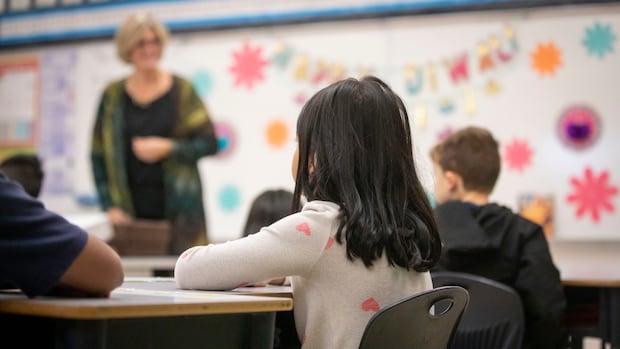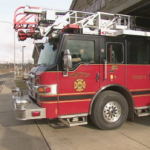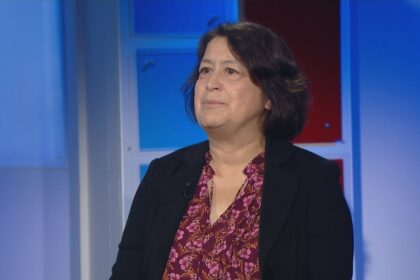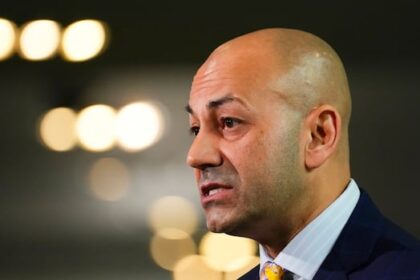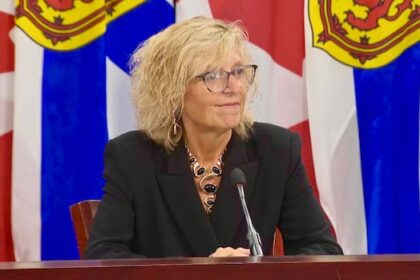Ontario’s education minister has singled out a handful of Ontario school boards for their financial struggles, but a look at recent estimates shows nearly two-thirds of the 72 boards are either projecting deficits this school year or expecting to just break even.Not all boards planning deficits are in trouble, but nor did so many previously operate so close to the line. With a few exceptions, the Education Act requires boards not to run deficits.In media interviews, Education Minister Paul Calandra has said trustees at the five school boards under provincial control “refused to make the right decisions” to keep their budgets balanced.”It’s a per pupil funding model,” Calandra pointed out in an interview on CBC Toronto’s Metro Morning on Sept. 5. “A vast majority of [boards] are able to run a very effective system with a surplus.”Metro MorningOntario’s Minister of Education Paul Calandra considers eliminating school boardsAs students return to the classroom, Ontario’s Minister of Education Paul Calandra is considering eliminating oversight of school boards at the local level. He says it could free up resources, but it is being met with criticism from students, teachers and advocates.Calandra is considering eliminating or changing the roles of trustees, and intends to present a plan before the end of the year.But one expert who tracks school boards says the five under the microscope — Ottawa-Carleton District School Board, Dufferin-Peel Catholic School Board, Thames Valley District School Board and Toronto’s public and Catholic boards — aren’t one-offs, but instead part of a larger trend caused by the way Ontario funds local school boards.”When you see such widespread difficulties among school boards being able to balance their budgets, that shows you this isn’t an issue of financial mismanagement,” said Sachin Maharaj, an assistant professor in the faculty of education at the University of Ottawa. “This is a systemic issue.”Teacher turnover, special education costs School board finances are complicated, involving many types of grants and a lot of reporting to the government. Each board is required to submit early estimates, revise those estimates, then submit year-end financial statements.The estimates the 72 boards filed this past summer for the 2025-26 school year show 25 approved deficit budgets while another 19 just managed to balance their books, often after making difficult cuts. Surpluses among the remaining 28 boards were small compared to years past, and almost all surpluses this school year are projected to be less than $500,000.As recently as the 2021-22 school year, a report by the Financial Accountability Office reported 15 boards were in deficit while the other 57 recorded surpluses. An auditor general’s report a few years ago also said most boards ran surpluses in 2019-20 because of rigid rules.Boards have struggled since losing their taxation powers under the Mike Harris government in the 1990s, explains Maharaj, but those problems were exacerbated by the pandemic. “There’s a widespread teacher shortage not just in Ontario but all across Canada,” he said. “Given the conditions in classrooms right now, it’s very hard to recruit and retain teachers.”Staffing classrooms when there’s such high turnover is expensive, Maharaj explained.Across Ontario, school boards report other common pressures. Parents on guard as OCDSB shifts supports for special needs Parents, teachers say Toronto schools already struggling as board mulls big cuts More kids are struggling to regulate their behaviour or have complicated needs that require educational assistants, which causes boards to overspend on special education. Pay increases, mandatory benefits and Canadian Pension Plan increases haven’t been entirely covered off by the province, they say.Calandra’s press secretary said Ontario is spending a record $30.3 billion on education for 2025-26, and expects all boards to spend every dollar directly on students and teachers. But the minister has also stated he’s open to reviewing the province’s funding formula if supervisors say it’s causing challenges.Not all deficits created equalSome boards under supervision are indeed planning deep deficits again this year.For example, Dufferin-Peel Catholic School Board foresees another shortfall of nearly $33 million. A financial investigation last spring shed light on why it’s in such poor shape: It’s one of the only boards that pays the full cost of long-term disability, and after claims rose during the pandemic it has accumulated deficits of more than $100 million. Dufferin-Peel has also lost 12 per cent of its student population in just seven years — enrolment has fallen to 70,500. That means less revenue because the lion’s share of education funding in Ontario comes from a core education grant based on the number of students enrolled in a board.”As enrolments have decreased in several school boards, this has placed a real financial strain and it’s impacted their ability to balance their budgets,” pointed out Maharaj. Sachin Maharaj, an assistant professor in the faculty of education at the University of Ottawa, says when so many school boards are struggling to balance their budgets it points to a systemic problem. (Michel Aspirot/CBC)Meanwhile, Dufferin-Peel has nearly 18,000 underused student spaces, but the province has had a moratorium on school closures since 2017.Other boards that are not under supervision, such as Greater Essex District School Board in Windsor, have also struggled to make cuts. ‘This stinks less than supervision’: Windsor-Essex school board passes budget with cuts But being in deficit does not necessarily mean a board is in trouble. Some boards went into the red on purpose to fund special projects. A board can get the minister’s approval to run a deficit if it amounts to less than one per cent of revenues and there’s a plan to get rid of it.For example, Renfrew County District School Board planned a $450,000 deficit so it could upgrade trades and shop equipment and implement a wellness system to try to reduce staff absences.Similarly, the Ottawa Catholic School Board is running a $5.6-million deficit this year to pay for play structures, outdoor learning spaces, skilled trades equipment and student mental health.Lisa Schimmens, associate director of business affairs, said Ottawa’s English Catholic board is in healthy shape and set money aside for those projects in its reserves, which she likens to a savings account.”So it’s not a structural deficit,” she said. “If that $5.6 million was to keep the lights on, then it’s a problem.”Ongoing deficitsIndeed, the minister’s attention has gone to boards that file deficits year after year, which accumulate into a bigger problem.Five boards are under supervision, but according to financial estimates, 11 boards expected to start the school year without any reserves left for operations.Meanwhile, five boards were projecting deficits beyond the one per cent of revenues allowed under legislation, including three where trustees remain in place.For instance, Simcoe Muskoka Catholic District School Board reported this summer it had accumulated deficits because it was spending more on special education to meet greater student needs. It planned to make cuts including 23 jobs over several years to get back to balance.York Catholic District School Board has also extinguished its reserves and tabled a deficit greater than allowed. Like Peel-Dufferin, the York Catholic board’s budget describes steadily losing students as demographics change. It now has 10,000 empty spaces.CBC News asked the education minister’s press secretary why some boards were taken over and others not, but did not receive a response by time of publication.Rising enrolment helps with inflationIn contrast, what’s kept the Ottawa Catholic School Board in good shape is a surge in enrolment, Schimmens says. It’s been adding at least 2,000 students a year, the equivalent of four elementary schools or one rural school board. Each additional student provides an average of $13,986 to the OCSB. That helps the board withstand inflation, Schimmens said. “If we weren’t growing, then it would be much more challenging,” she explained.Rapid growth brings its own challenges as the board adds portable classrooms and builds new schools, but it’s a good problem to have, Schimmens says.The Ottawa Catholic School Board is planning on a $5.6 million deficit for the 2025-26 school year, but the board set aside that money in reserves so it could make one-time upgrades to playgrounds, build outdoor learning spaces and buy equipment for trades. (Michel Aspirot/CBC)At Renfrew County Public School Board, director of education Kristen Niemi said the board has stable enrolment and reserves, but points to special pressures in smaller rural boards.Waitlists for the board’s speech and language pathologist and behavioural analyst are long. Still, the board spends on special education knowing those services aren’t as available in the community.Rural boards can also have some tiny schools spread across a large area. Whitney Public School, on the edge of Algonquin Park, has just 33 students. Keeping it heated and staffed is a different kind of pressure. To make it work, Renfrew County has cut jobs centrally and spread cuts widely to soften their impact. The board knows it must trim, because families are doing the same in the current economic climateStill, Niemi says, “It is getting harder and harder to make those decisions.”
Friday, 26 Dec 2025
Canada – The Illusion
Search
Have an existing account?
Sign In
© 2022 Foxiz News Network. Ruby Design Company. All Rights Reserved.
You May also Like
- More News:
- history
- Standing Bear Network
- John Gonzalez
- ᐊᔭᐦᑊ ayahp — It happened
- Creation
- Beneath the Water
- Olympic gold medal
- Jim Thorpe
- type O blood
- the bringer of life
- Raven
- Wás’agi
- NoiseCat
- 'Sugarcane'
- The rivers still sing
- ᑲᓂᐸᐏᐟ ᒪᐢᑿ
- ᐅᑳᐤ okâw — We remember
- ᐊᓂᓈᐯᐃᐧᐣ aninâpêwin — Truth
- This is what it means to be human.
- Nokoma


